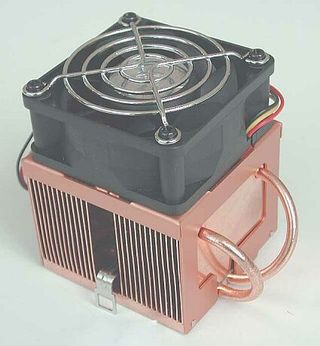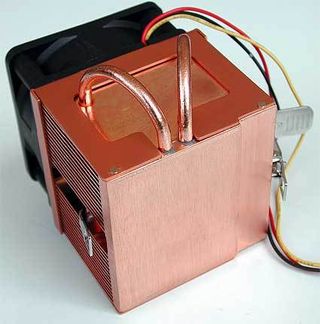A Cool Bunch: How To Put A Lid On The Die Temperature Of Your Athlon
Hot Pipes For High Speeds: CoolerMaster HHC-001
The HHC-001 looks pretty weird - two crooked pipes jut out of the cooler's solid-copper plate, like the y-joint on an engine. Then they disappear into the cooler, four centimeters above the copper plate. Once inside, they pierce the thin copper ribs before reappearing on the other side of the housing.


Why does the design have to be so bizarre? Well, the cooling fins are much smaller and a third longer than those on the HCC-002. But there aren't more of them. In thermal terms, thinner and longer ribs alone don't offer any advantages.
Indeed, the law of thermal conduction states:
Q/t = A/l.*λ*(T2-T1)
According to this equation, merely lengthening the ribs (l) will worsen the thermal conduction within the cooler, since the heat will have to take a longer route.
And this is where the heatpipes come in. They shorten the path the heat takes. True to their name, the thermal superconductors transport the heat at almost the speed of sound from the hot seat of the cooler to the cool area at the tips of the fins. This complex design reveals its strengths when combined with processors that dissipate an exceptionally large amount of heat. The measurement curve demonstrates that it is superior to a conventional copper cooler with shorter, but thicker cooling, ribs.

Like its little brother, the HHC-001 has the right stuff to become an overclocking cooler, albeit a loud one.
Stay on the Cutting Edge
Join the experts who read Tom's Hardware for the inside track on enthusiast PC tech news — and have for over 25 years. We'll send breaking news and in-depth reviews of CPUs, GPUs, AI, maker hardware and more straight to your inbox.
Current page: Hot Pipes For High Speeds: CoolerMaster HHC-001
Prev Page The Mighty Roaring Cube: CoolerMaster HCC-002 Next Page A Cooler, Too: ElanVital FSCUG9C-6Most Popular

